Financial Plan: Passenger Transportation Company, 2-Year Project
VerifiedAdded on 2022/09/07
|10
|1104
|23
Project
AI Summary
This project presents a comprehensive financial plan for a startup passenger transportation company, covering a two-year projection. The plan includes detailed income statements, projected cash flow statements, and balance sheets, along with a funding plan, break-even analysis, and financial feasibility assessment. The student outlines key assumptions, financial management strategies (cash method), and tax considerations. The plan also addresses recordkeeping processes, staffing, and potential financial problems with corresponding contingency plans. The business model focuses on six buses in the first year and expanding to eight in the second, with revenue projections based on monthly sales per bus. The financial analysis covers operating expenses, gross profit calculations, and the identification of critical financial challenges, providing a practical guide for managing a transportation business.
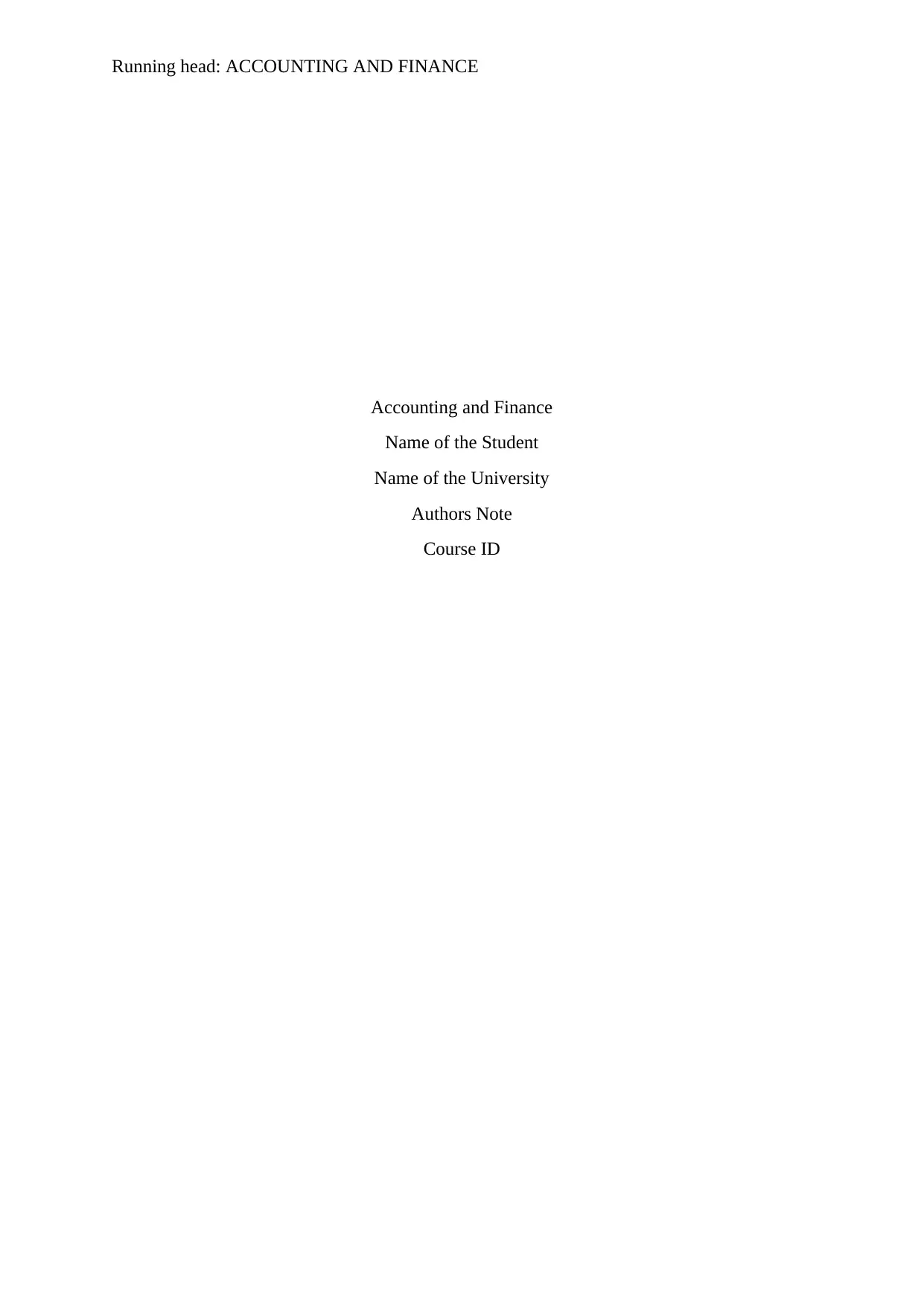
Running head: ACCOUNTING AND FINANCE
Accounting and Finance
Name of the Student
Name of the University
Authors Note
Course ID
Accounting and Finance
Name of the Student
Name of the University
Authors Note
Course ID
Paraphrase This Document
Need a fresh take? Get an instant paraphrase of this document with our AI Paraphraser
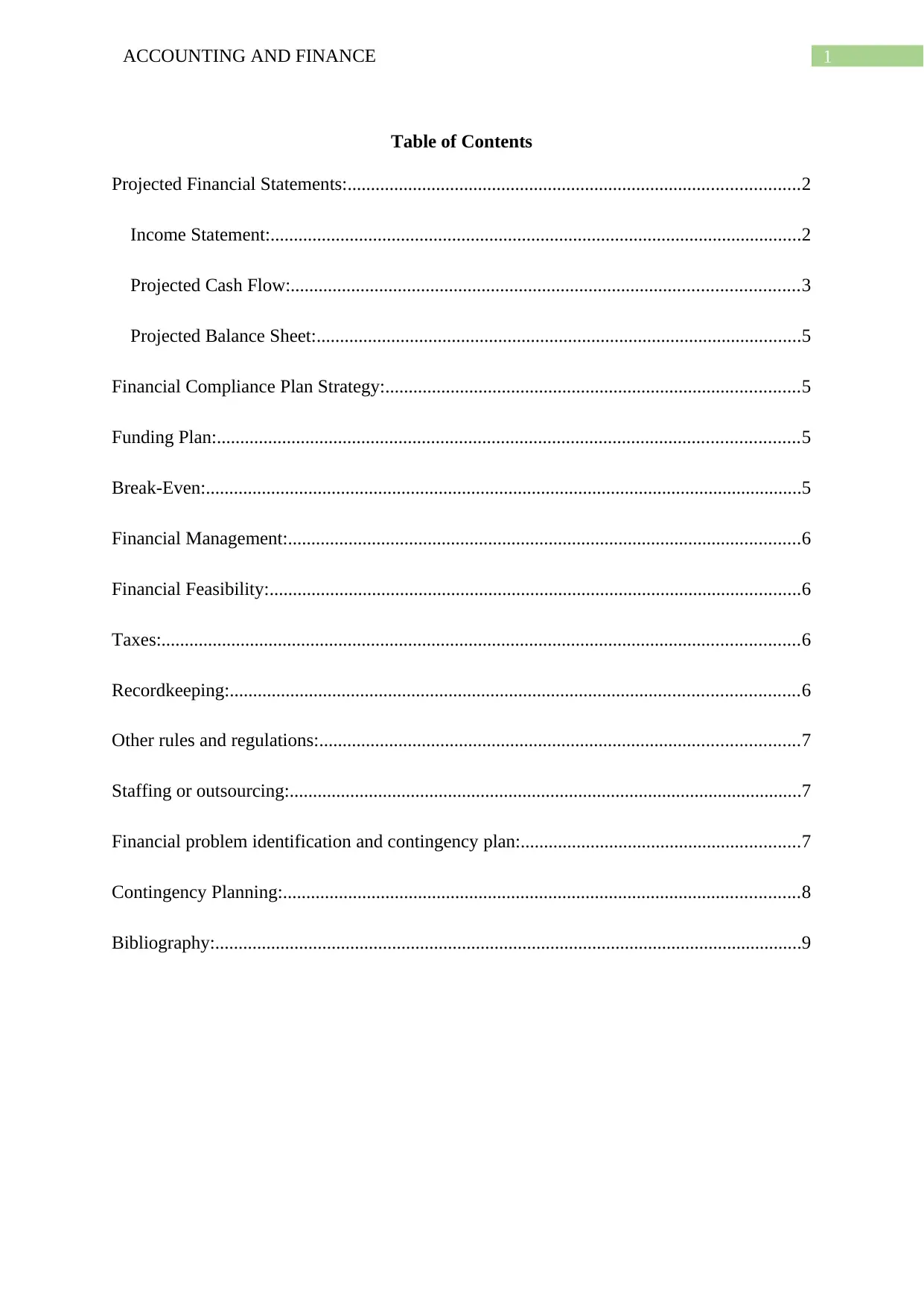
1ACCOUNTING AND FINANCE
Table of Contents
Projected Financial Statements:.................................................................................................2
Income Statement:..................................................................................................................2
Projected Cash Flow:.............................................................................................................3
Projected Balance Sheet:........................................................................................................5
Financial Compliance Plan Strategy:.........................................................................................5
Funding Plan:.............................................................................................................................5
Break-Even:................................................................................................................................5
Financial Management:..............................................................................................................6
Financial Feasibility:..................................................................................................................6
Taxes:.........................................................................................................................................6
Recordkeeping:..........................................................................................................................6
Other rules and regulations:.......................................................................................................7
Staffing or outsourcing:..............................................................................................................7
Financial problem identification and contingency plan:............................................................7
Contingency Planning:...............................................................................................................8
Bibliography:..............................................................................................................................9
Table of Contents
Projected Financial Statements:.................................................................................................2
Income Statement:..................................................................................................................2
Projected Cash Flow:.............................................................................................................3
Projected Balance Sheet:........................................................................................................5
Financial Compliance Plan Strategy:.........................................................................................5
Funding Plan:.............................................................................................................................5
Break-Even:................................................................................................................................5
Financial Management:..............................................................................................................6
Financial Feasibility:..................................................................................................................6
Taxes:.........................................................................................................................................6
Recordkeeping:..........................................................................................................................6
Other rules and regulations:.......................................................................................................7
Staffing or outsourcing:..............................................................................................................7
Financial problem identification and contingency plan:............................................................7
Contingency Planning:...............................................................................................................8
Bibliography:..............................................................................................................................9
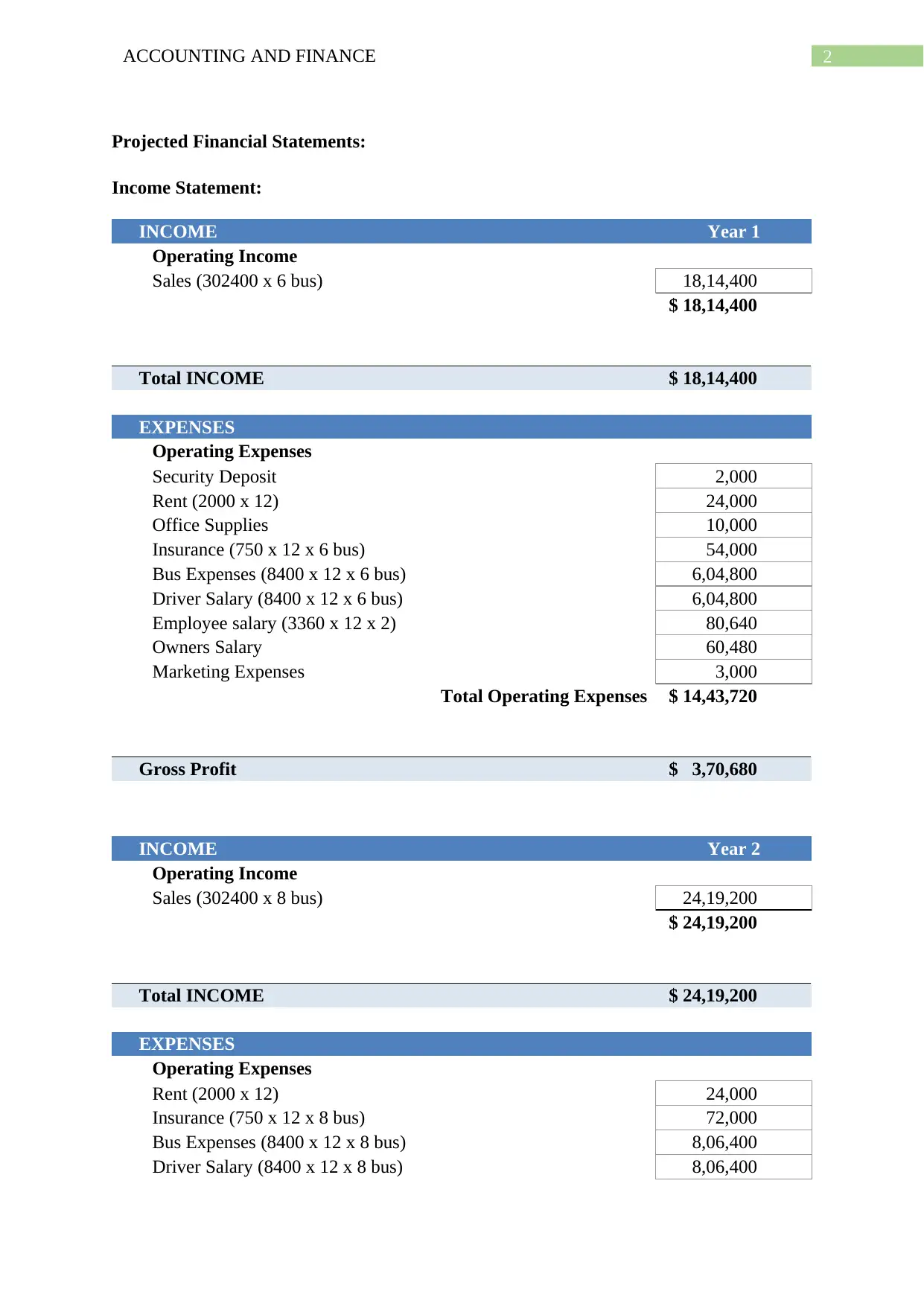
2ACCOUNTING AND FINANCE
Projected Financial Statements:
Income Statement:
INCOME Year 1
Operating Income
Sales (302400 x 6 bus) 18,14,400
$ 18,14,400
Total INCOME $ 18,14,400
EXPENSES
Operating Expenses
Security Deposit 2,000
Rent (2000 x 12) 24,000
Office Supplies 10,000
Insurance (750 x 12 x 6 bus) 54,000
Bus Expenses (8400 x 12 x 6 bus) 6,04,800
Driver Salary (8400 x 12 x 6 bus) 6,04,800
Employee salary (3360 x 12 x 2) 80,640
Owners Salary 60,480
Marketing Expenses 3,000
Total Operating Expenses $ 14,43,720
Gross Profit $ 3,70,680
INCOME Year 2
Operating Income
Sales (302400 x 8 bus) 24,19,200
$ 24,19,200
Total INCOME $ 24,19,200
EXPENSES
Operating Expenses
Rent (2000 x 12) 24,000
Insurance (750 x 12 x 8 bus) 72,000
Bus Expenses (8400 x 12 x 8 bus) 8,06,400
Driver Salary (8400 x 12 x 8 bus) 8,06,400
Projected Financial Statements:
Income Statement:
INCOME Year 1
Operating Income
Sales (302400 x 6 bus) 18,14,400
$ 18,14,400
Total INCOME $ 18,14,400
EXPENSES
Operating Expenses
Security Deposit 2,000
Rent (2000 x 12) 24,000
Office Supplies 10,000
Insurance (750 x 12 x 6 bus) 54,000
Bus Expenses (8400 x 12 x 6 bus) 6,04,800
Driver Salary (8400 x 12 x 6 bus) 6,04,800
Employee salary (3360 x 12 x 2) 80,640
Owners Salary 60,480
Marketing Expenses 3,000
Total Operating Expenses $ 14,43,720
Gross Profit $ 3,70,680
INCOME Year 2
Operating Income
Sales (302400 x 8 bus) 24,19,200
$ 24,19,200
Total INCOME $ 24,19,200
EXPENSES
Operating Expenses
Rent (2000 x 12) 24,000
Insurance (750 x 12 x 8 bus) 72,000
Bus Expenses (8400 x 12 x 8 bus) 8,06,400
Driver Salary (8400 x 12 x 8 bus) 8,06,400
⊘ This is a preview!⊘
Do you want full access?
Subscribe today to unlock all pages.

Trusted by 1+ million students worldwide
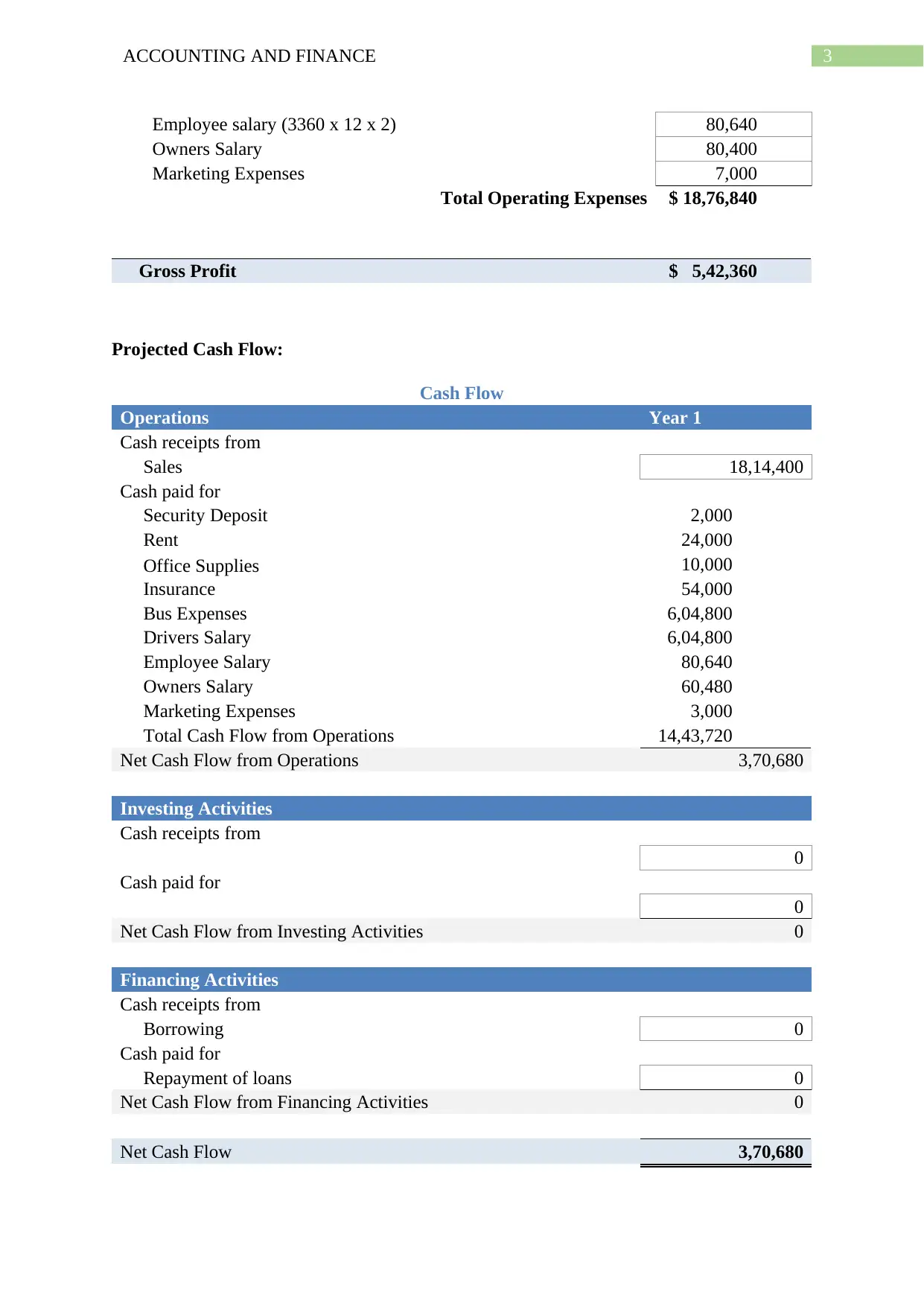
3ACCOUNTING AND FINANCE
Employee salary (3360 x 12 x 2) 80,640
Owners Salary 80,400
Marketing Expenses 7,000
Total Operating Expenses $ 18,76,840
Gross Profit $ 5,42,360
Projected Cash Flow:
Cash Flow
Operations Year 1
Cash receipts from
Sales 18,14,400
Cash paid for
Security Deposit 2,000
Rent 24,000
Office Supplies 10,000
Insurance 54,000
Bus Expenses 6,04,800
Drivers Salary 6,04,800
Employee Salary 80,640
Owners Salary 60,480
Marketing Expenses 3,000
Total Cash Flow from Operations 14,43,720
Net Cash Flow from Operations 3,70,680
Investing Activities
Cash receipts from
0
Cash paid for
0
Net Cash Flow from Investing Activities 0
Financing Activities
Cash receipts from
Borrowing 0
Cash paid for
Repayment of loans 0
Net Cash Flow from Financing Activities 0
Net Cash Flow 3,70,680
Employee salary (3360 x 12 x 2) 80,640
Owners Salary 80,400
Marketing Expenses 7,000
Total Operating Expenses $ 18,76,840
Gross Profit $ 5,42,360
Projected Cash Flow:
Cash Flow
Operations Year 1
Cash receipts from
Sales 18,14,400
Cash paid for
Security Deposit 2,000
Rent 24,000
Office Supplies 10,000
Insurance 54,000
Bus Expenses 6,04,800
Drivers Salary 6,04,800
Employee Salary 80,640
Owners Salary 60,480
Marketing Expenses 3,000
Total Cash Flow from Operations 14,43,720
Net Cash Flow from Operations 3,70,680
Investing Activities
Cash receipts from
0
Cash paid for
0
Net Cash Flow from Investing Activities 0
Financing Activities
Cash receipts from
Borrowing 0
Cash paid for
Repayment of loans 0
Net Cash Flow from Financing Activities 0
Net Cash Flow 3,70,680
Paraphrase This Document
Need a fresh take? Get an instant paraphrase of this document with our AI Paraphraser
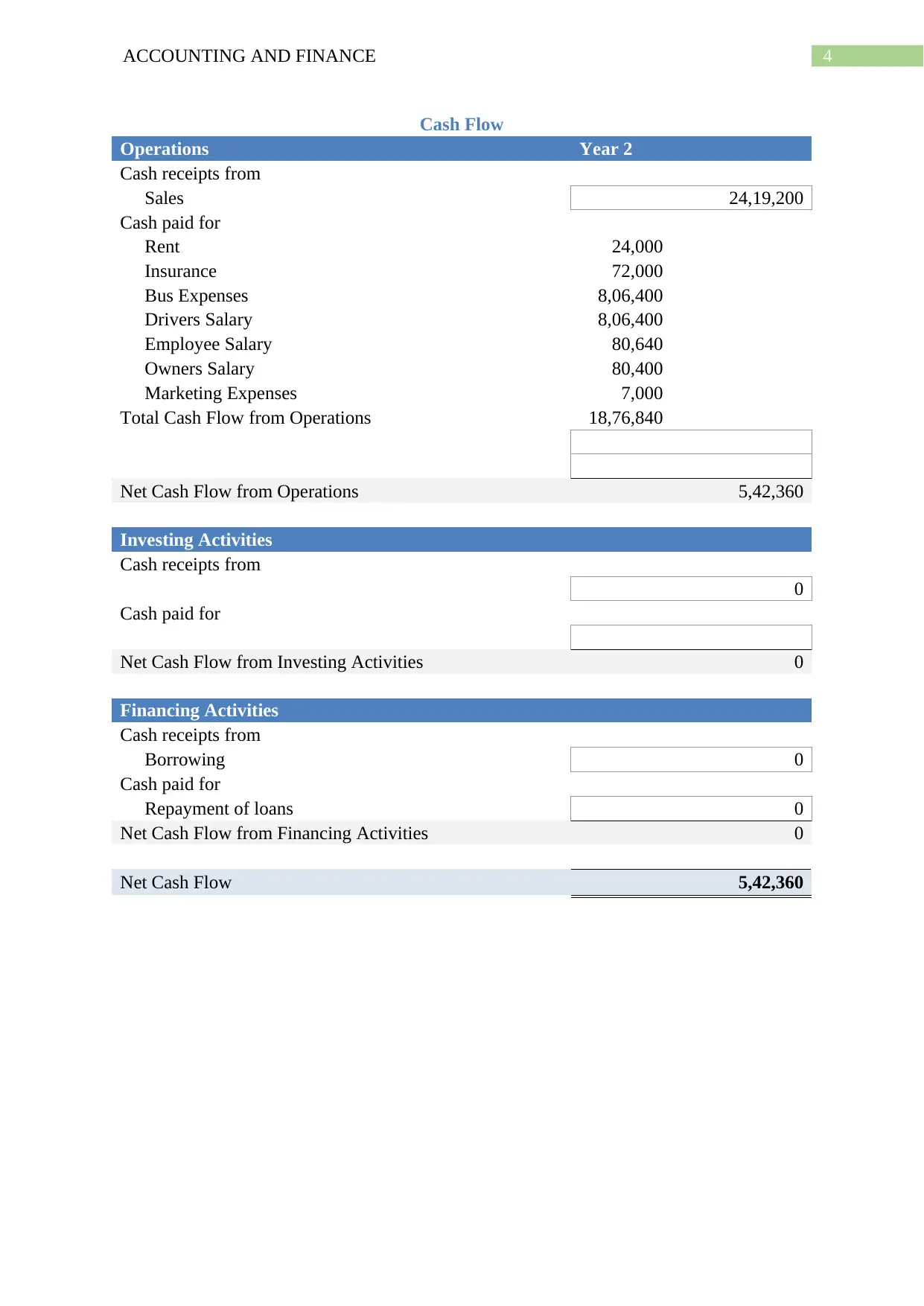
4ACCOUNTING AND FINANCE
Cash Flow
Operations Year 2
Cash receipts from
Sales 24,19,200
Cash paid for
Rent 24,000
Insurance 72,000
Bus Expenses 8,06,400
Drivers Salary 8,06,400
Employee Salary 80,640
Owners Salary 80,400
Marketing Expenses 7,000
Total Cash Flow from Operations 18,76,840
Net Cash Flow from Operations 5,42,360
Investing Activities
Cash receipts from
0
Cash paid for
Net Cash Flow from Investing Activities 0
Financing Activities
Cash receipts from
Borrowing 0
Cash paid for
Repayment of loans 0
Net Cash Flow from Financing Activities 0
Net Cash Flow 5,42,360
Cash Flow
Operations Year 2
Cash receipts from
Sales 24,19,200
Cash paid for
Rent 24,000
Insurance 72,000
Bus Expenses 8,06,400
Drivers Salary 8,06,400
Employee Salary 80,640
Owners Salary 80,400
Marketing Expenses 7,000
Total Cash Flow from Operations 18,76,840
Net Cash Flow from Operations 5,42,360
Investing Activities
Cash receipts from
0
Cash paid for
Net Cash Flow from Investing Activities 0
Financing Activities
Cash receipts from
Borrowing 0
Cash paid for
Repayment of loans 0
Net Cash Flow from Financing Activities 0
Net Cash Flow 5,42,360
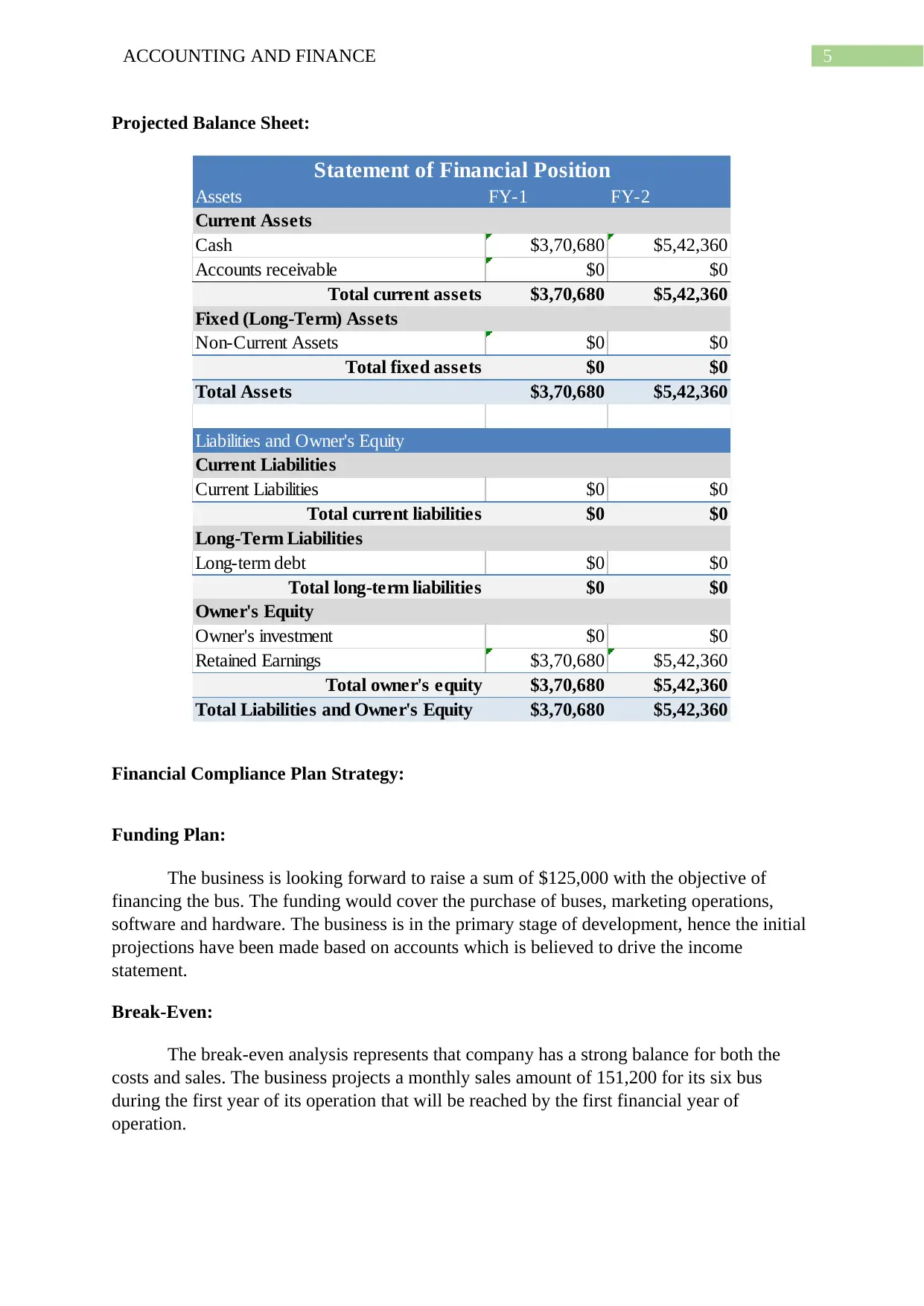
5ACCOUNTING AND FINANCE
Projected Balance Sheet:
Assets FY-1 FY-2
Current Assets
Cash $3,70,680 $5,42,360
Accounts receivable $0 $0
Total current assets $3,70,680 $5,42,360
Fixed (Long-Term) Assets
Non-Current Assets $0 $0
Total fixed assets $0 $0
Total Assets $3,70,680 $5,42,360
Liabilities and Owner's Equity
Current Liabilities
Current Liabilities $0 $0
Total current liabilities $0 $0
Long-Term Liabilities
Long-term debt $0 $0
Total long-term liabilities $0 $0
Owner's Equity
Owner's investment $0 $0
Retained Earnings $3,70,680 $5,42,360
Total owner's equity $3,70,680 $5,42,360
Total Liabilities and Owner's Equity $3,70,680 $5,42,360
Statement of Financial Position
Financial Compliance Plan Strategy:
Funding Plan:
The business is looking forward to raise a sum of $125,000 with the objective of
financing the bus. The funding would cover the purchase of buses, marketing operations,
software and hardware. The business is in the primary stage of development, hence the initial
projections have been made based on accounts which is believed to drive the income
statement.
Break-Even:
The break-even analysis represents that company has a strong balance for both the
costs and sales. The business projects a monthly sales amount of 151,200 for its six bus
during the first year of its operation that will be reached by the first financial year of
operation.
Projected Balance Sheet:
Assets FY-1 FY-2
Current Assets
Cash $3,70,680 $5,42,360
Accounts receivable $0 $0
Total current assets $3,70,680 $5,42,360
Fixed (Long-Term) Assets
Non-Current Assets $0 $0
Total fixed assets $0 $0
Total Assets $3,70,680 $5,42,360
Liabilities and Owner's Equity
Current Liabilities
Current Liabilities $0 $0
Total current liabilities $0 $0
Long-Term Liabilities
Long-term debt $0 $0
Total long-term liabilities $0 $0
Owner's Equity
Owner's investment $0 $0
Retained Earnings $3,70,680 $5,42,360
Total owner's equity $3,70,680 $5,42,360
Total Liabilities and Owner's Equity $3,70,680 $5,42,360
Statement of Financial Position
Financial Compliance Plan Strategy:
Funding Plan:
The business is looking forward to raise a sum of $125,000 with the objective of
financing the bus. The funding would cover the purchase of buses, marketing operations,
software and hardware. The business is in the primary stage of development, hence the initial
projections have been made based on accounts which is believed to drive the income
statement.
Break-Even:
The break-even analysis represents that company has a strong balance for both the
costs and sales. The business projects a monthly sales amount of 151,200 for its six bus
during the first year of its operation that will be reached by the first financial year of
operation.
⊘ This is a preview!⊘
Do you want full access?
Subscribe today to unlock all pages.

Trusted by 1+ million students worldwide
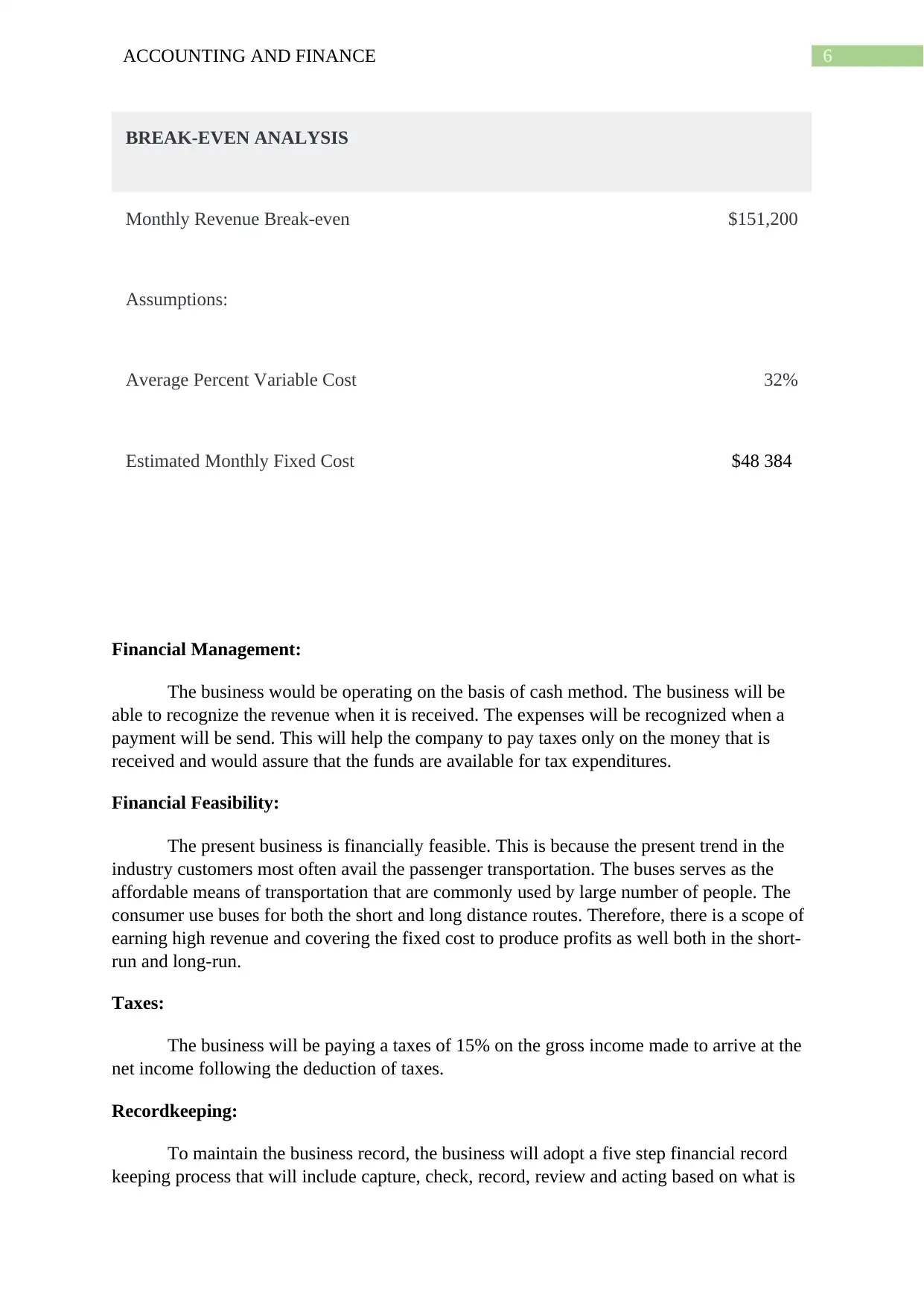
6ACCOUNTING AND FINANCE
BREAK-EVEN ANALYSIS
Monthly Revenue Break-even $151,200
Assumptions:
Average Percent Variable Cost 32%
Estimated Monthly Fixed Cost $48 384
Financial Management:
The business would be operating on the basis of cash method. The business will be
able to recognize the revenue when it is received. The expenses will be recognized when a
payment will be send. This will help the company to pay taxes only on the money that is
received and would assure that the funds are available for tax expenditures.
Financial Feasibility:
The present business is financially feasible. This is because the present trend in the
industry customers most often avail the passenger transportation. The buses serves as the
affordable means of transportation that are commonly used by large number of people. The
consumer use buses for both the short and long distance routes. Therefore, there is a scope of
earning high revenue and covering the fixed cost to produce profits as well both in the short-
run and long-run.
Taxes:
The business will be paying a taxes of 15% on the gross income made to arrive at the
net income following the deduction of taxes.
Recordkeeping:
To maintain the business record, the business will adopt a five step financial record
keeping process that will include capture, check, record, review and acting based on what is
BREAK-EVEN ANALYSIS
Monthly Revenue Break-even $151,200
Assumptions:
Average Percent Variable Cost 32%
Estimated Monthly Fixed Cost $48 384
Financial Management:
The business would be operating on the basis of cash method. The business will be
able to recognize the revenue when it is received. The expenses will be recognized when a
payment will be send. This will help the company to pay taxes only on the money that is
received and would assure that the funds are available for tax expenditures.
Financial Feasibility:
The present business is financially feasible. This is because the present trend in the
industry customers most often avail the passenger transportation. The buses serves as the
affordable means of transportation that are commonly used by large number of people. The
consumer use buses for both the short and long distance routes. Therefore, there is a scope of
earning high revenue and covering the fixed cost to produce profits as well both in the short-
run and long-run.
Taxes:
The business will be paying a taxes of 15% on the gross income made to arrive at the
net income following the deduction of taxes.
Recordkeeping:
To maintain the business record, the business will adopt a five step financial record
keeping process that will include capture, check, record, review and acting based on what is
Paraphrase This Document
Need a fresh take? Get an instant paraphrase of this document with our AI Paraphraser
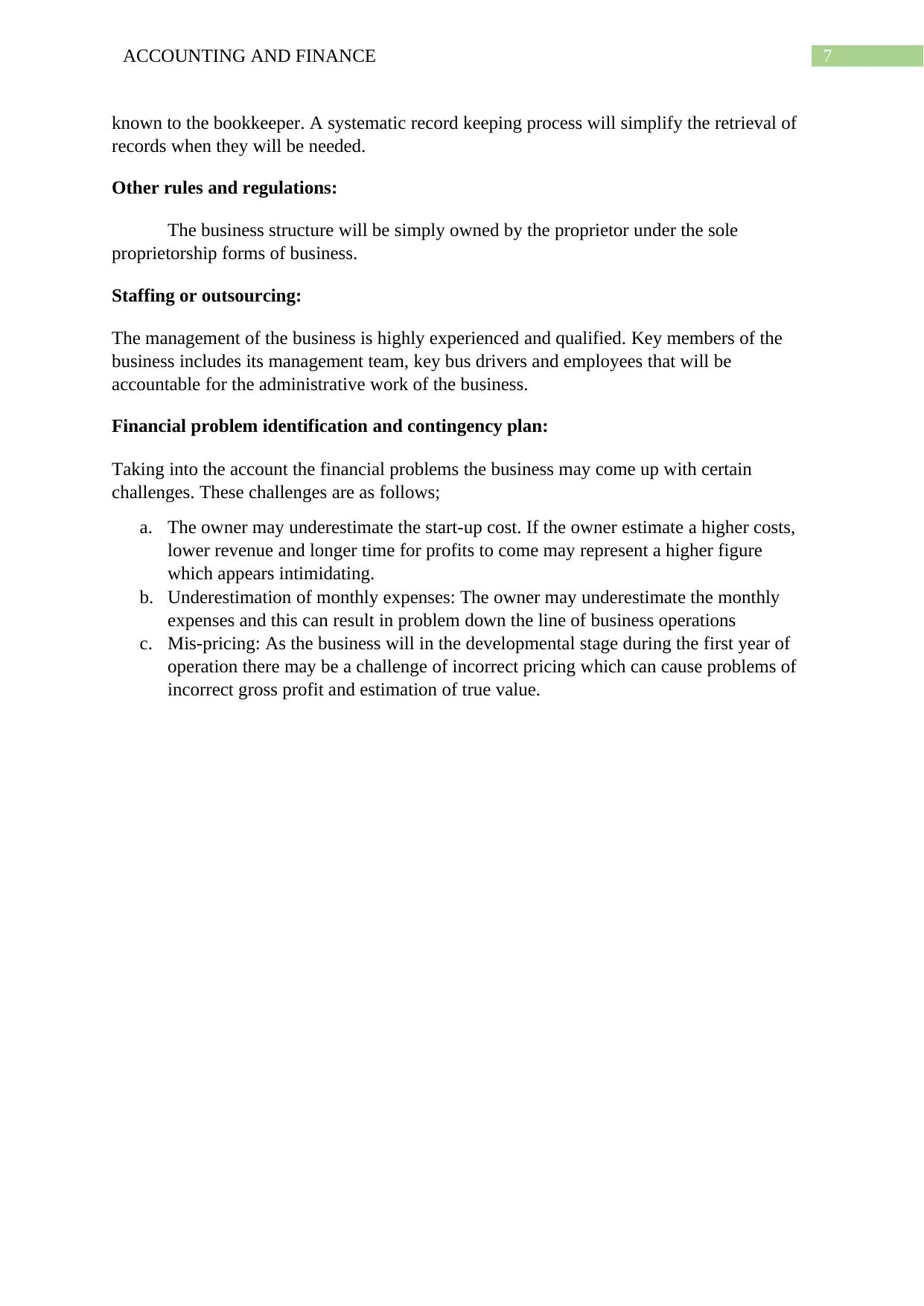
7ACCOUNTING AND FINANCE
known to the bookkeeper. A systematic record keeping process will simplify the retrieval of
records when they will be needed.
Other rules and regulations:
The business structure will be simply owned by the proprietor under the sole
proprietorship forms of business.
Staffing or outsourcing:
The management of the business is highly experienced and qualified. Key members of the
business includes its management team, key bus drivers and employees that will be
accountable for the administrative work of the business.
Financial problem identification and contingency plan:
Taking into the account the financial problems the business may come up with certain
challenges. These challenges are as follows;
a. The owner may underestimate the start-up cost. If the owner estimate a higher costs,
lower revenue and longer time for profits to come may represent a higher figure
which appears intimidating.
b. Underestimation of monthly expenses: The owner may underestimate the monthly
expenses and this can result in problem down the line of business operations
c. Mis-pricing: As the business will in the developmental stage during the first year of
operation there may be a challenge of incorrect pricing which can cause problems of
incorrect gross profit and estimation of true value.
known to the bookkeeper. A systematic record keeping process will simplify the retrieval of
records when they will be needed.
Other rules and regulations:
The business structure will be simply owned by the proprietor under the sole
proprietorship forms of business.
Staffing or outsourcing:
The management of the business is highly experienced and qualified. Key members of the
business includes its management team, key bus drivers and employees that will be
accountable for the administrative work of the business.
Financial problem identification and contingency plan:
Taking into the account the financial problems the business may come up with certain
challenges. These challenges are as follows;
a. The owner may underestimate the start-up cost. If the owner estimate a higher costs,
lower revenue and longer time for profits to come may represent a higher figure
which appears intimidating.
b. Underestimation of monthly expenses: The owner may underestimate the monthly
expenses and this can result in problem down the line of business operations
c. Mis-pricing: As the business will in the developmental stage during the first year of
operation there may be a challenge of incorrect pricing which can cause problems of
incorrect gross profit and estimation of true value.
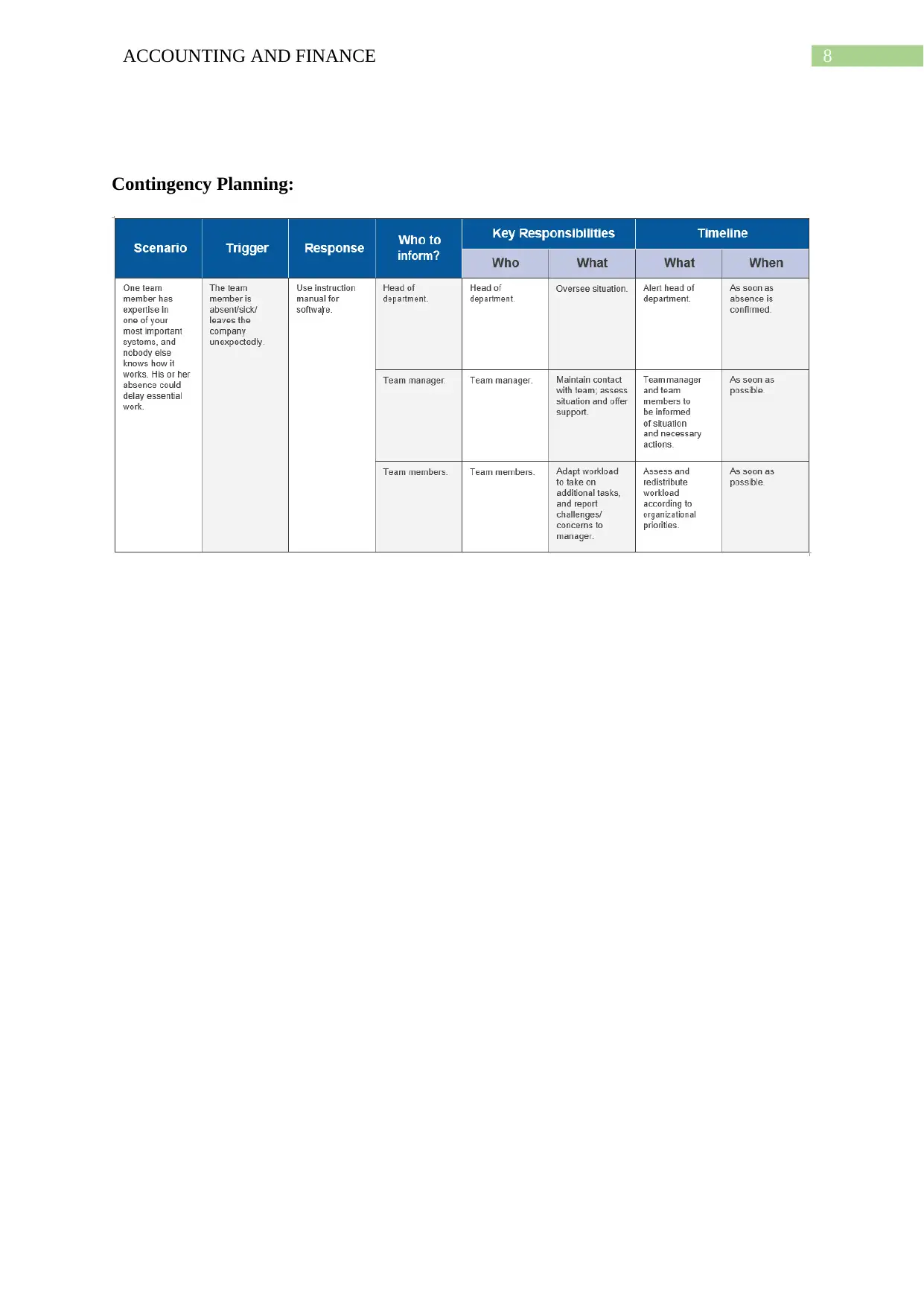
8ACCOUNTING AND FINANCE
Contingency Planning:
Contingency Planning:
⊘ This is a preview!⊘
Do you want full access?
Subscribe today to unlock all pages.

Trusted by 1+ million students worldwide
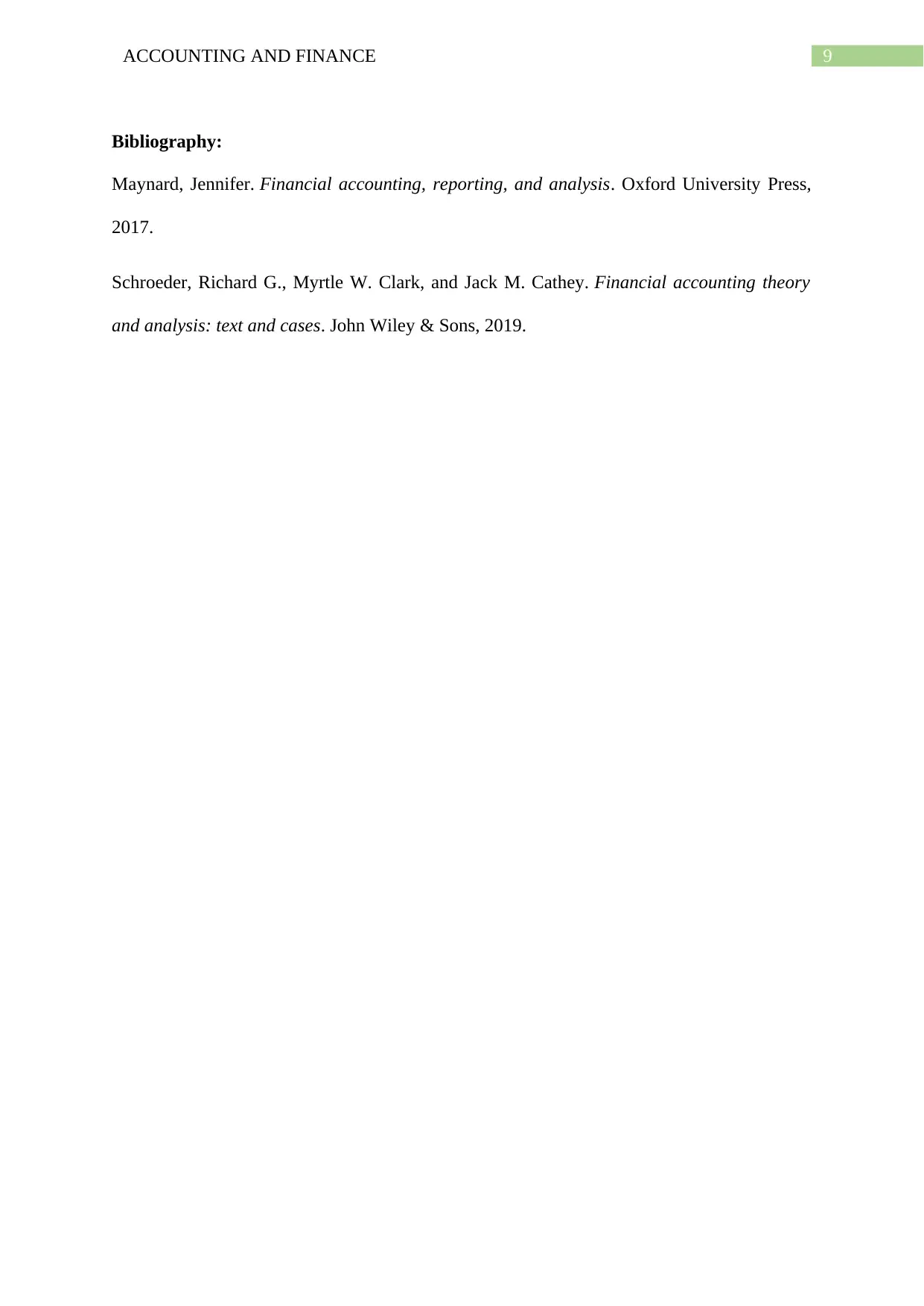
9ACCOUNTING AND FINANCE
Bibliography:
Maynard, Jennifer. Financial accounting, reporting, and analysis. Oxford University Press,
2017.
Schroeder, Richard G., Myrtle W. Clark, and Jack M. Cathey. Financial accounting theory
and analysis: text and cases. John Wiley & Sons, 2019.
Bibliography:
Maynard, Jennifer. Financial accounting, reporting, and analysis. Oxford University Press,
2017.
Schroeder, Richard G., Myrtle W. Clark, and Jack M. Cathey. Financial accounting theory
and analysis: text and cases. John Wiley & Sons, 2019.
1 out of 10
Related Documents
Your All-in-One AI-Powered Toolkit for Academic Success.
+13062052269
info@desklib.com
Available 24*7 on WhatsApp / Email
![[object Object]](/_next/static/media/star-bottom.7253800d.svg)
Unlock your academic potential
Copyright © 2020–2025 A2Z Services. All Rights Reserved. Developed and managed by ZUCOL.





